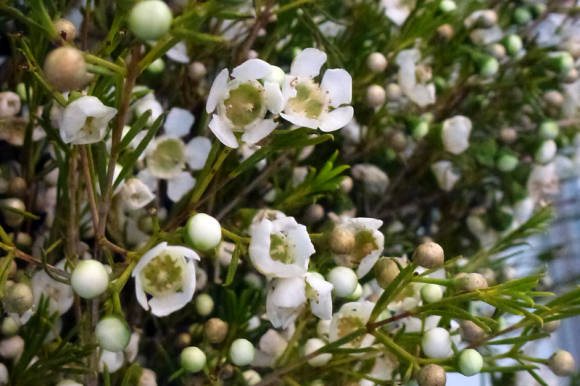Nandina home (Nandinadomestica) - the only species of the genus Nandina(Nandina), belonging to the Barberry family (Berberidaceae). This plant comes from China and Japan, where it grows on mountain slopes.
In Chinese and Japanese gardens, nandina has been cultivated for centuries. In Japan, where it is most popular, there are over 65 varieties and the National Nandina Society. It was believed that the bright red berries of nandina scare away demons, protect from misfortune. The twigs of the plant are used to decorate home altars and temples during the New Year celebrations.
Nandine was brought to the West by William Kerr, who sent her to London in his first shipment from Canton (then Guangzhou) in 1804. The scientific name given to it by Karl Peter Thunberg is the Latinized version of the Japanese Nanten, which roughly translates as "turn bad into good, turn back difficulties." Nandina is now widely known throughout the world as Sacred Bamboo or Heavenly Bamboo.
 |  |  |
Despite its common name, nandina is not bamboo. It is an upright evergreen shrub up to 2-6 m in height with a cylindrical openwork crown about 1.5 m in diameter, with numerous, usually unbranched stems growing from the ground level. Glossy leaves 50-100 cm long, double or triple pinnate, with individual leaves 4-11 cm long and 1.5-3 cm wide, collected at the ends of branches. The characteristic "reed" stems and compound leaves resembling bamboo in shape, as well as the active growth of root shoots, gave the plant the nickname.
Young leaves in spring are brightly colored red, then turn green, but in autumn and winter they again acquire a red or purple hue, and before the start of spring growth they turn green again. The flowers are white, about 6 mm in diameter, appear in early summer in conical inflorescences, apical panicles 20-40 cm long, well protruding above the foliage. Fruits are bright red berries with a diameter of 5-10 mm, ripen in autumn and often persist throughout the winter.

All parts of the plant contain compounds that decompose to release hydrogen cyanide and can potentially be harmful if swallowed. The plant is generally considered non-toxic to humans, but the berries are poisonous to pets and birds.
Growth shape, delicate foliage, spring and fall coloration make nandina an interesting outdoor plant and can be grown in USDA hardiness zones 6 to 10. Outdoors, it is considered evergreen in warm climates in USDA zones 8-10. In cooler climates, nandina is a semi-leafy or deciduous plant. Shoots can die off when the temperature drops below zero, but with the arrival of heat, new ones grow to replace them.
In Russia, nandina was introduced into the culture by the Nikitsky Botanical Garden in 1846; it can grow in subtropical regions, in the Crimea and the Caucasus.
In the open field, nandina is undemanding to the composition of the soil, but prefers rich, well-drained and moderately moist. Its foliage grows best in full sun or light partial shade. Mature plants have some drought tolerance, but regular watering is preferable. The best fruiting is observed in group cultivation. Nandina can survive a short-term drop in temperature to -23 ° C and an increase to + 43 ° C.
But, despite its high decorativeness, the cultivation of nandina is limited in certain countries, it is recognized as an invasive species in several warm states of the United States, where it has successfully naturalized, and is also considered a potentially dangerous plant in Australia. Nandina is rapidly propagated by seeds carried by birds, thereby capturing large areas and displacing local flora. It is difficult to eradicate this plant, its underground shoots grow rapidly and resume after cutting. In these countries, varieties are used that do not produce seeds or produce few seeds.
In colder climates, nandina is an excellent container crop or kept as a pot plant. It is very popular in the technique of growing bonsai.Mostly compact varieties with bright foliage or unusual flowering are cultivated.
- Alba - variety with white berries and yellowish-green foliage, which turns yellow in autumn.
- Compacta - undersized cultivar, reaching a height of 120-150 cm, with lacy foliage, which turns red in autumn.
- Fire Power - a very compact plant, up to 60 cm in height and width. The leaves are red in summer and bright red in winter.
- Gulf stream - a slow-growing variety up to 90-120 cm high with blue-green summer foliage and red winter foliage. Does not bear fruit.
- Harbour Dwarf - dwarf cultivar, growing only up to 60 cm, in winter the foliage is orange or bronze-red.
- WoodsDwarf - a globular variety up to 120 cm with dense foliage, which turns red in winter.
- Moyer's Red - 120-180 cm tall and 60-150 cm in diameter, has light pink flowers.
- Royal princess - up to 2.5 meters, with pale pink and white inflorescences. In autumn, numerous red berries appear, the foliage becomes orange-red.
In conclusion - 3 new items of recent years:
- Twilight - isolated mutation of the 'Gulf Stream' cultivar. The young leaves are pink with irregular white strokes and turn green as they age, creating a beautiful contrast to the newly growing young leaves. Compact, has a dense spherical crown, not exceeding 0.5 m in diameter.
- BrightLight Is an elegant cultivar with radiant yellow-green foliage and an upright form of growth. The leaves are longer than other varieties. In adulthood, the plant is 1.50 m high and 50 cm wide.
- Magical Lemon & Lime - young leaves are pale yellow, they turn light green in summer, and orange-red in autumn and winter. A compact variety with a rounded crown, about 60 cm in diameter, does not need pruning.
About cultivation - in the article Nandina: room care.

 |  |
Photo by Rita Brilliantova, Galina Vlasenok and from the GreenInfo.ru forum









